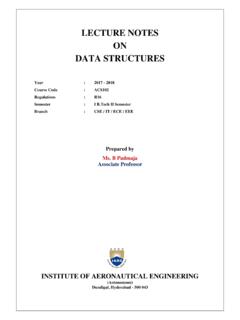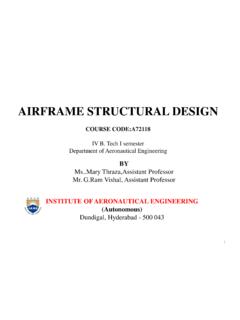Transcription of DESIGN AND ANALYSIS OF ALGORITHMS
1 1 | P a g e DESIGN AND ANALYSIS OF ALGORITHMS LAB MANUAL Year : 2017 - 2018 Course Code : AIT101 Regulations : IARE - R16 Semester : III Branch : CSE/IT Prepared by Dr. K Rajendra Prasad, Professor Dr. R Obulakonda Reddy, Professor Dr. B. V. Rao, Professor Dr. G. Ramu, Professor Mr. Ch. Suresh Kumar Raju, Assistant Professor Ms. K. Radhika, Assistant Professor INSTITUTE OF AERONAUTICAL ENGINEERING (Autonomous) Dundigal, Hyderabad - 500 043 2 | P a g e INSTITUTE OF AERONAUTICAL ENGINEERING (Autonomous) Dundigal, Hyderabad - 500 043 1.
2 PROGRAM OUTCOMES: - PROGRAM OUTCOMES (POS) PO-1 Apply the knowledge of mathematics, science, engineering fundamentals, and an engineering specialization to the solution of complex engineering problems(Engineering knowledge). PO-2 Identify, formulate, review research literature, and analyze complex engineering problems reaching substantiated conclusions using first principles of mathematics, natural sciences, and engineering sciences (Problem ANALYSIS ). PO-3 DESIGN solutions for complex engineering problems and DESIGN system components or processes that meet the specified needs with appropriate consideration for the public health and safety, and the cultural, societal, and environmental considerations ( DESIGN /development of solutions).
3 PO-4 Use research-based knowledge and research methods including DESIGN of experiments, ANALYSIS and interpretation of data , and synthesis of the information to provide valid conclusions (Conduct investigations of complex problems). PO-5 Create, select, and apply appropriate techniques, resources, and modern engineering and IT tools including prediction and modeling to complex engineering activities with an understanding of the limitations (Modern tool usage). PO-6 Apply reasoning informed by the contextual knowledge to assesssocietal, health, safety, legal and cultural issues and the consequent responsibilities relevant to the professional engineering practice (The engineer and society).
4 PO-7 Understand the impact of the professional engineering solutions in societal and environmental contexts, and demonstrate the knowledge of, and need for sustainable development (Environment and sustainability). PO-8 Apply ethical principles and commit to professional ethics and responsibilities and norms of the engineering practice (Ethics). PO-9 Function effectively as an individual, and as a member or leader in diverse teams, and in multidisciplinary settings (Individual and team work). PO-10 Communicate effectively on complex engineering activities with the engineering community and with society at large, such as, being able to comprehend and write effective reports and DESIGN documentation, make effective presentations, and give and receive clear instructions (Communication).
5 PO-11 Demonstrate knowledge and understanding of the engineering and management principles and apply these to one s own work, as a member and leader in a team, to manage projects and in multidisciplinary environments (Project management and finance). PO-12 Recognize the need for, and have the preparation and ability to engage in independent and life-long learning in the broadest context of technological change (Life-long learning). 3 | P a g e 2. PROGRAM SPECIFIC OUTCOMES PROGRAM SPECIFIC OUTCOMES (PSO's) PSO-1 Professional Skills: The ability to understand, analyze and develop computer programs in the areas related to ALGORITHMS , system software, multimedia, web DESIGN , big data analytics , and networking for efficient DESIGN of computer-based systems of varying complexity.
6 PSO-2 Problem-Solving Skills: The ability to apply standard practices and strategies in software project development using open-ended programming environments to deliver a quality product for business success. PSO-3 Successful Career and Entrepreneurship: The ability to employ modern computer languages, environments, and platforms in creating innovative career paths to be an entrepreneur, and a zest for higher studies. 4 | P a g e 3. ATTAINMENT OF PROGRAM OUTCOMES AND PROGRAM SPECIFIC OUTCOMES: Experiment Program Outcomes Attained Program Specific Outcomes Attained WEEK-l QUICK SORT PO-2,PO-3 PSO-1 Sort a given set of elements using the quick sort method and determine the time required to sort the elements.
7 Repeat the experiment for different values of n, the number of elements in the 1st to be sorted and plot a graph of the time taken versus n. The elements can be read from a file or can be generated using the random number generator. WEEK-2 MERGE SORT PO-2,PO-3 PSO-1 Implement merge sort algorithm to sort a given set of elements and determine the time required to sort the elements. Repeat the experiment for different values of n, the number of elements in the list to be sorted and plot a graph of the time taken versus n. The elements can be read from a file or can be generated using the random number generator.
8 WEEK-3 WARSHALL S ALGORITHM PO-2 a. Obtain the Topological ordering of vertices in a given digraph. b. Compute the transitive closure of a given directed graph using Warshall's algorithm. WEEK-4 KNAPSACK PROBLEM PO-3 PSO-1 Implement 0/1 Knapsack problem using Dynamic Programming. WEEK-5 SHORTEST PATHS ALGORITHM PO-3 PSO-1 From a given vertex in a weighted connected graph, find shortest paths to other vertices using Dijkstra s algorithm. 5 | P a g e WEEK-6 MINIMUM COST SPANNING TREE PO-3 PSO-1 Find Minimum Cost Spanning Tree of a given undirected graph using Kruskal s algorithm.
9 WEEK-7 TREE TRAVESRSALS PO-2,PO-3 Perform various tree traversal ALGORITHMS for a given tree. WEEK-8 GRAPH TRAVERSALS PO-2,PO-3 a. Print all the nodes reachable from a given starting node in a digraph using BFS method. 6 | P a g e b. Check whether a given graph is connected or not using DFS method. WEEK-9 SUM OF SUB SETS PROBLEM PO-3 Find a subset of a given set S = {sl, s2,.., sn} of n positive integers whose sum is equal to a given positive integer d. For example, if S= {1, 2, 5, 6, 8} and d = 9 there are two solutions {1, 2, 6} and {1,8}.A suitable message is to be displayed if the given problem instance doesn't have a solution.
10 WEEK-l0 TRAVELLING SALES PERSON PROBLEM PO-3,PO-12 PSO-1 Implement any scheme to find the optimal solution for the Traveling Sales Person problem and then solve the same problem instance using any approximation algorithm and determine the error in the approximation. WEEK-l1 MINIMUM COST SPANNING TREE PO-3 PSO-1 Find Minimum Cost Spanning Tree of a given undirected graph using Prim s algorithm. 7 | P a g e WEEK-l2 ALL PAIRS SHORTEST PATHS PO-3 PSO-1 Implement All-Pairs Shortest Paths Problem using Floyd's algorithm. WEEK-l3 N QUEENS PROBLEM PO-3 PSO-1 Implement N Queen's problem using Back Tracking.











